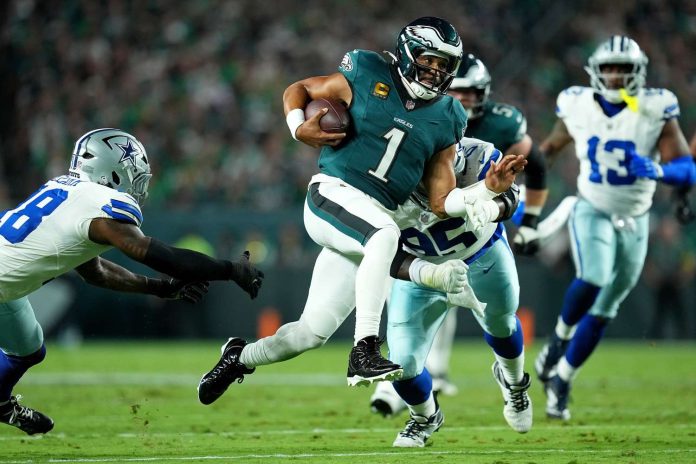Inside the NFL: A Look at Players, Salaries, and Team Valuations
The excitement of the NFL season is back, and along with it comes a peek into the world of professional football salaries and team valuations. You might be amazed to know how much players, both on the active roster and in practice squads, earn in a league where every penny counts. Today, let’s dive into the fascinating financial side of the NFL, from the generous salaries of star quarterbacks to the surprising earnings of practice squad players.
A Roster of Disparities
At any moment during the NFL season, there are just 53 players on the active roster of each team. It’s quite an exclusive club, and you might be surprised to learn that even the players on the lowest end of this salary spectrum earn a hefty $840,000 for the season. But what about those who are not yet part of the active roster? Enter the practice squad, where 17 players train and support the team without the flashiness of game day fame.
The Hidden Heroes: Practice Squad Players
Although practice squad players don’t don the official jerseys on game days, they still play a crucial role in a football team’s success. They train alongside the main roster, helping to prepare the starters by simulating plays and tackling strategies. And while they may not be in the spotlight, they are not without compensation. Rookies and players with one year of service can bring in $13,000 each week. If they stay the entire 18-week season, that adds up to a tidy $234,000.
Veterans with two or more years can earn more, raking in between $17,500 and $22,000 weekly. This means they could finish the season with earnings between $315,000 and $396,000. While the cash flow isn’t guaranteed and there are no signing bonuses, it’s clear that being on the practice squad can still lead to hefty payouts.
Breiden Fehoko: A Case Study
Take, for example, Breiden Fehoko, a veteran defensive tackle. Recently released by the Pittsburgh Steelers, he summed up the practice squad’s lucrative side with a cheeky social media post, quipping about his $400,000 salary for six months of work. It’s an eye-opener, isn’t it? What might seem like ‘just’ a practice squad role is still life-changing money for many.
The Big Dollars: Star Players
Now let’s shift gears to the other end of this financial spectrum. At the top of the payroll ladder is Dallas Cowboys quarterback Dak Prescott, slated to earn a jaw-dropping $60 million this season. That amount comes from a substantial four-year, $240 million contract extension signed last year. Interestingly, Prescott is among an elite group of just 11 players expected to earn $50 million or more in the upcoming years. All of them? Quarterbacks.
The Billion-Dollar Franchise: Cowboys vs. Cardinals
While individual player salaries are impressive, the teams that these athletes represent are also worth billions. According to a recent report by CNBC, the average NFL franchise’s value rose by 18%, reaching $7.65 billion. Leading the pack is the Dallas Cowboys, valued at a staggering $12.5 billion. The franchise has a knack for raking in revenue, generating about $300 million from sponsorships last year alone.
Even the “least valuable” franchise, the Arizona Cardinals, isn’t doing too shabby at a worth of $5.9 billion. This financial strength is reflected in the high viewing numbers, with 72 out of the 100 most-watched broadcasts last year being NFL games.
The Power of Media Rights
A surprising nugget from CNBC highlights the power of media deals, bringing in an average of $12.4 billion annually for the league. For teams like the Cowboys, managing these deals has become just as critical as game day performance. The ability to attract sponsors and maximize media revenue is as much of a strategic play as scoring touchdowns.
Why Does This Matter?
The world of the NFL is a fascinating mix of sport, business, and strategy. Understanding how players are compensated and how teams generate revenue gives us insight not just into the league itself but also into American sports culture as a whole.
Financial Education Through Sport
This dive into the NFL’s financials also serves as a lesson in financial literacy. For many young athletes dreaming of the NFL, understanding money management is crucial. It’s eye-opening to see how financial success can look very different, depending on whether you’re a star player or working hard behind the scenes.
Moreover, this wealth gap within the league can inspire discussions about equity, salaries, and the economics of sports in general. Players like Dak Prescott represent exceptional talent and marketability, while those like Breiden Fehoko remind us of the hard work and dedication that underpins every great team.
Personal Reflections: What We Can Learn
Reflecting on this data, it’s clear that financial success in sports often mirrors broader societal trends. From income inequality to the corporate nature of entertainment, the financial dynamics at play offer valuable lessons.
It’s vital for young athletes to recognize that the road to success is varied; some might find themselves in high-paying positions, while others may need to rely on perseverance and grit. This dynamic serves as a reminder that whether in sports, business, or life, the journey involves hard work, skill development, and sometimes a touch of luck.
In conclusion, the NFL is not just about touchdowns and highlight reels; it’s a complex ecosystem of player salaries, franchise valuations, and economic strategies. As fans, players, or simply as observers of society, we have much to learn from the financial landscape of professional sports. Whether you aspire to be the next Dak Prescott or find your niche behind the scenes, the story of the NFL offers insights on ambition, value, and the pursuit of excellence. So as you tune in to your favorite team this season, remember what’s at stake—it’s more than just a game; it’s big business too.

